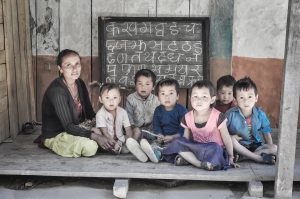An executive decision by the Trump administration in Washington, D.C. to freeze foreign aid for 90 days and a potential shutdown of USAID has created ripple effects in the faraway Himalayan republic of Nepal. The decision will impact Nepal’s development, diplomacy, and geopolitics.
On January 25, USAID formally contacted Dhaniram Sharma, the head of the International Economic Cooperation Division of the Ministry of Finance, notifying him of the pause in all ongoing U.S. grants to Nepal. Two days later, a Foreign Ministry spokesperson announced that the Development Objective Agreement (DOAG) signed between Nepal and USAID on May 5, 2022, was being halted for 90 days. The agreement includes four “On-Budget On-Treasury” programs for health, agriculture, education, and inclusion.
According to Nepal’s Ministry of Finance data, of the $695 million worth of USAID-supported projects in Nepal, $411 million was committed in the last fiscal year.
Former Foreign Minister Ramesh Nath Pandey said that the U.S. aid freeze will have both immediate and long-term impacts on Nepal. “Nepal established diplomatic relations with the U.S. even before it did so with its immediate neighbors — India and China. This uniqueness was reflected in U.S. aid to Nepal,” he told The Diplomat. “The self-centered foreign policy” of the Trump administration, is downgrading, if not fully shutting down, aid, Pandey pointed out.
Ram Prashad Subedi, chairperson of the NGO Federation of Nepal, an umbrella organization of Nepali NGOs, many of which are directly bankrolled by USAID, said the “unexpected decision by the U.S. government has badly hit all U.S.-funded projects and NGO programs in Nepal and would deal a major blow to projects in child health, nutrition, environment, and climate change, in particular.” Around 1,500 people have lost their jobs following the U.S. foreign aid freeze announcement, he said.
“The U.S. has been Nepal’s major donor since 1954 and even today it is the largest grant provider in Nepal, including both governmental and non-governmental channels. Even in the Cold War era, it was ahead of its competitor, the Soviet Union, in aiding Nepal,” award-winning economic journalist Gajendra Budhathoki told The Diplomat, pointing out that the aid freeze will make the U.S. “less visible in Nepal.”
“The U.S. withdrawal from WHO, together with the potential freeze of over a dozen health-related programs, will create problems in Nepal’s health sector,” Budhathoki added.
Veteran media researcher Ujjwal Acharya told The Diplomat that “the pause on the funds to Nepal will slow its advancement towards achieving an impactful civic space, and its efforts to fight the threats of misinformation.”
Besides the aid freeze, Trump’s order recognizing only two genders — male and female — has Nepal’s LGBTQ+ community worried. Sunil Babu Panta, a sexual rights activist and Asia’s first openly gay parliamentarian, said that Nepal’s 15 plus LGBTQ+ organizations will lose their steady funds and over 300 members of the community could lose their jobs. “While this will impact U.S.-funded organizations, projects and jobs, it will not impact the entire LGBTQI community as condoms are affordable, anti-retroviral therapy for HIV and sexual health programs are already included in the government budget,” Panta said.
However, some have welcomed the U.S. aid freeze. A former minister and influential leader of the ruling Communist Party of Nepal-United Marxist Leninist, who spoke to The Diplomat on condition of anonymity, said that “USAID had invested huge sums of money in political parties, the parliament, newsrooms, and courtrooms and created outsize influence in poor, aid-hungry remittance-run Nepal.”
“Foreign aid cuts on social engineering will make Nepali institutions stronger and independent,” he said.
However, the aid freeze will not apply to the $500 million Millennium Challenge Corporation program. Nepal joined the MCC in 2017 and its parliament ratified the agreement in 2022. An additional $50 million was added to the Millennium Challenge Account-Nepal compact recently.
Its aid to Nepal over the past 74 years has made the U.S. omnipresent in the Himalayan country. From establishing the framework of Nepal’s first university, Tribhuvan University, to the eradication of malaria in Nepal’s southern plains, from modernizing the government’s accounting system to the pioneering land reforms in Nepal — the U.S. was everywhere. The pause in its aid to Nepal will make the U.S. less visible and less powerful.
Who will fill the vacuum? It could be plugged either by China or India, or the European allies of the United States.

































